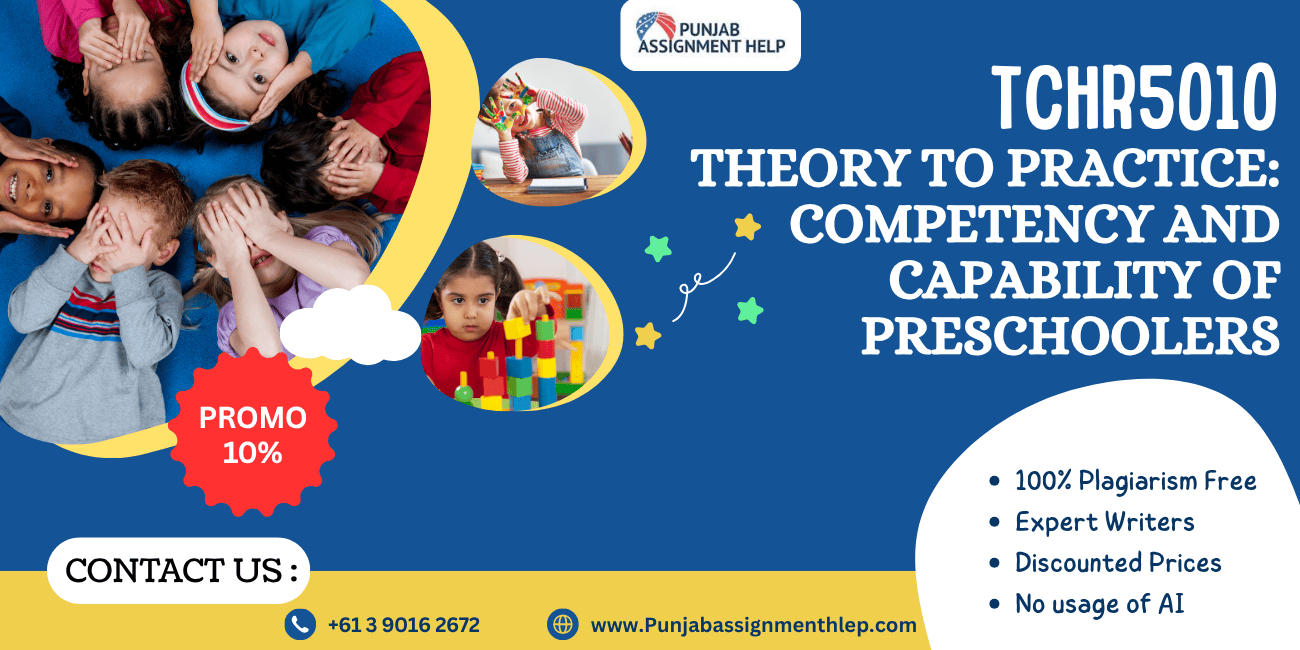
TCHR5010 Theory to practice: Competency and capability of Preschoolers
Assessment One: Portfolio
Information Booklet
| Assessment name: | Portfolio |
| Due Date: | Friday,18th July 2025 by 11:59 pm |
| Weighting: | 50% |
| Length: | 1500 words(10%+/-) |
| Task Description: | This Portfolio is comprised of two tasks submitted as one Word document. Write in full paragraphs with no bullet points/numbered lists Task 1: Professional Philosophy (approximately 500 words) Write your professional philosophy statement for working with Preschool age children. Include four(4) important aspects of preschoolers’ learning and development that we have been focusing on in the unit from the following: Diversity and inclusion Relationships Quality Transition to school Supporting pro-social competencies Links to relevant theoretical perspectives must be made.
Task 2: Goals and Critical reflection (approximately 1000 words) Set 4 personal goals that you want to achieve on your forthcoming professional experience with Preschoolers.Critically reflect on these goals and consider 1 challenge that could prevent you from achieving each goal (4 challenges in total).Discuss how you will overcome each challenge. Make links to the unit text, the NQS and EYLF in your discussions. |
| Referencing and formatting |
Formatting: Use APA 7 formatting throughout (this includes indented paragraphs, double-lined spacing). No contents page is needed for this task. Referencing Style Resource AboutAPA7th-APA7thReferencingGuide-LibraryguidesatSouthernCrossUniversity(scu.edu.au) |
| Resources |
National Quality Standard https://www.acecqa.gov.au/nqf/national-quality-standard Early Years Learning Frame work https://www.acecqa.gov.au/sites/default/files/2023-01/EYLF-2022-V2.0.pdf |
DetailsoftheUnittextareavailableviatheOrientationModuleontheunitBlackboardsite. | |
| Support Resources | The work shops for this unit will fully unpack the task requirements. Academic Integrity–SCU guidelines Academic Integrity Module-mandatory module for first year students Learning Zone– workshops, Quick Guides |
| Submission | You must include and complete in full the provided SCU cover sheet as part of your submission (this can be found in the Assessment task folder on the TCHR5010 unit Blackboard site).
Submission of your assessment is via TURN IT IN. The submission link can be found in the Assessment Tasks and Submission Tab in the TCHR5010 Black board site.
Please note:
| ||
| Late Submission/ Extension | Please refer to the Special Consideration section of Policy https://policies.scu.edu.au/document/view-current.php?id=140 | ||
Students wishing to request special consideration to extend the due date of an assessment task must submit a Request for Special Consideration form via their My Enrolment page as early as possible and prior to the original due date for that assessment task,along with any accompanying documents,such as medical certificates.
Late Submissions & Penalties Please refer to the Late Submission & Penalties section of Policy | |||
| Academic Integrity | At Southern Cross University academic integrity means behaving with the values of honesty, fairness, trustworthiness, courage, responsibility and respect in relation to academic work. The Southern Cross University Academic Integrity Framework aims to develop a holistic,systematic and consistent approach to addressing academic integrity across the entire University. For more information see the SCU Academic Integrity Framework.
For this task: Generative Artificial Intelligence (Gen AI) tools, such as Grammarly Premium, may be used ethically for this Assessment Task. However, you must write in your own words and provideappropriatereferences(APA7).Then,tofurtherrefineyourassessmentyouareallowedtouseAItools such as Grammarly and Copilot to check your grammar, spelling and punctuation.
You must acknowledge any Gen AI usage, identify what has been used and how, and provide relevant evidence (e.g., screen shots) in an appendix.
If you use GenAI tools without acknowledgment it may result in an academic integrity breach against you as described in the Student Academic and Non-Academic Mis conduct Rules,Section 3. | ||
For example: You may use Grammarly Premium to provide feedback and suggestions on your writing for academic tone, written expression, grammar, Australian English spelling, and punctuation.You must not use Gen AI to generate ideas for this assessment task. If you choose to use these tools, you must include an appendix to demonstrate your work prior to using GenAI.
NOTE: Academic Integrity breaches include poor referencing, not identifying direct quotations correctly,close paraphrasing,plagiarism,recycling,misrepresentation,collusion,cheating,contract cheating, fabricating information. | |
| Grades and Feedback | Assessments that have been submitted by the due date will receive an SCU grade. Grades and feedback will be posted to the‘ Grades and Feedback’ section on the Black board unit site.Please allow 10 days following submission for marks to be available. |
Assessment 1 Rubric (TCHR5010)
| Marking Criteria and & allocation | High Distinction+ (100%) | High Distinction(85-99%) | Distinction(75-84%) | Credit (65-74%) | Pass (50-64%) | Marginal Fail (35-49%) | Fail (0-49%) | Notaddressed(0%) |
Criterion 1 Professional Philosophy Clarity, coherence, and critical engagement with 4 important aspects (e.g., relationships,quality, diversity,inclusion, transition,pro-social development) | Outstanding articulation of philosophy with deep critical insight and seamless integration of unit themes | Clear,coherent, and critically informed philosophy with excellent integration of unit themes | Well-structured philosophy with good critical thought and integration of key ideas | Sound articulation with some critical engagement; mostly integrates key concepts | Basic articulation with limited depth; concepts addressed but not well developed | Superficial or vague ideas with limited reference to unit content | Philosophy poorly expressed or largely off- topic | Not attempted or entirely missing |
Criterion 2 Goal Setting & Relevance Quality, clarity, and relevance of goals for professional placement; alignment with preschool context | Goals are highly relevant,specific,measurable, and show exceptional insight into professional growth | Goals are clear,appropriate, and reflect a strong understanding of professional context | Goals are appropriate and well considered; reflect good understanding of preschool settings | Goals show some relevance and understanding; partially developed | Goals are simplistic or general but meet basic expectations | Goals lack clarity,relevance,or understanding of professional placement | Goals are inappropriate or absent of educational context | Not addressed or omitted entirely |
Criterion 3 Critical Reflection & challenges. Depth of critical reflection on each goal; identification and analysis of challenges and responses | Exceptional depth of critical reflection; insightful and proactive strategies clearly linked to literature and frameworks | Thorough reflection and realistic strategies; strong use of references and frame work links | Good critical thought and logical responses;appropriate references used | Adequate reflection: challenge resolution lacks some detail; limited reference integration | Some reflection present but minimal depth; weak link to frameworks/literature | Incomplete reflection; minimal understanding of challenges or solutions | Very limited or flawed reflection;no clear resolution strategies | No reflection or response to goals/challenges present |
Criterion 4 Academic Literacy including correct word count, correct writing conventions, use of professional language and academic referencing (APA 7th style). A minimum of 8 academic references included. (15%) | Flaw less use of academic writing conventions and APA referencing with a comprehensive range of high- quality,authoritative sources.All references are accurately formatted and seamlessly integrated into the content. Word count within +/-10%of the set word count. | Accurate academic writing and APA referencing with a strong range of relevant sources.Very minor formatting errors may be present. Word count within +/- 10% of the set word count. | Good academic writing and APA referencing with a range of appropriate sources,though there may be some errors or inconsistencies in formatting. Word count within +/- 10% of the set word count. | Adequate academic writing and referencing with some relevant sources.Some minor and inconsistent errors with formatting. Word count within +/- 10% of the set word count. | Basic academic writing and referencing with limited sources. Some errors and inconsistencies with formatting. Word count with in+/- 10% of the set word count. | Poor standard of academic writing and referencing with consistent errors in most/all areas Word count significantly under or over +/- 10% of the set word count for the task | Significant improvement needed in academic writing and referencing. Referencing is absent, incorrect,or irrelevant | Not attempted |
High Distinction:
Distinction:
The student’s performance, in addition to satisfying all of the basic learning requirements,demonstrates distinctive insight and ability in researching, analysing and applying relevant skills and concepts, and shows a well-developed ability to synthesise, integrate and evaluate knowledge. The student’s performance could be described as distinguished in relation to the learning requirements specified.
Get Plagiarism free Assignment help from Punjab Assignment Help
Credit:
The student’s performance, in addition to satisfying all of the basic learning requirements specified, demonstrates insight and ability in researching, analysing and applying
relevant skills and concepts. The student’s performance could be described as competent in relation to the learning requirements specified.
Online Assignment Help in Australia
Pass:
The student’s performance satisfies all of the basic learning requirements specified and provides a sound basis for proceeding to higher-level studies in the subject area.The
student’s performance could be described as satisfactory in relation to the learning requirements specified.
Fail:
The student’s performance fails to satisfy the learning requirements specified.


Get original papers written according to your instructions and save time for what matters most.